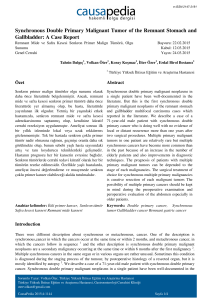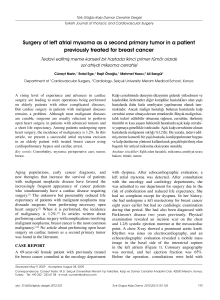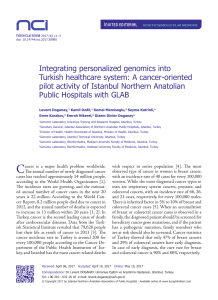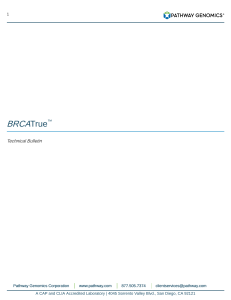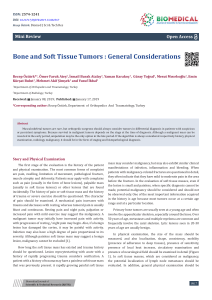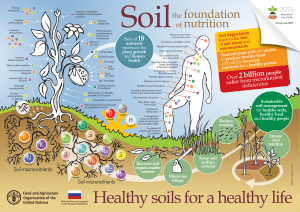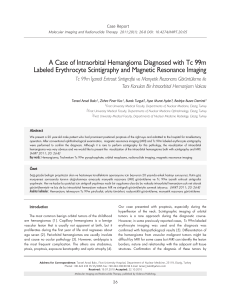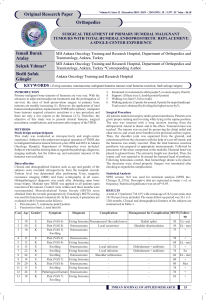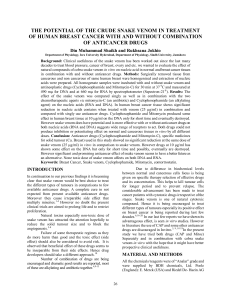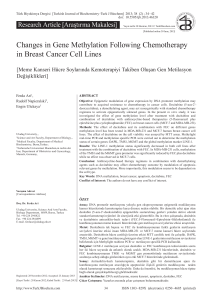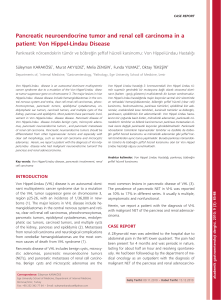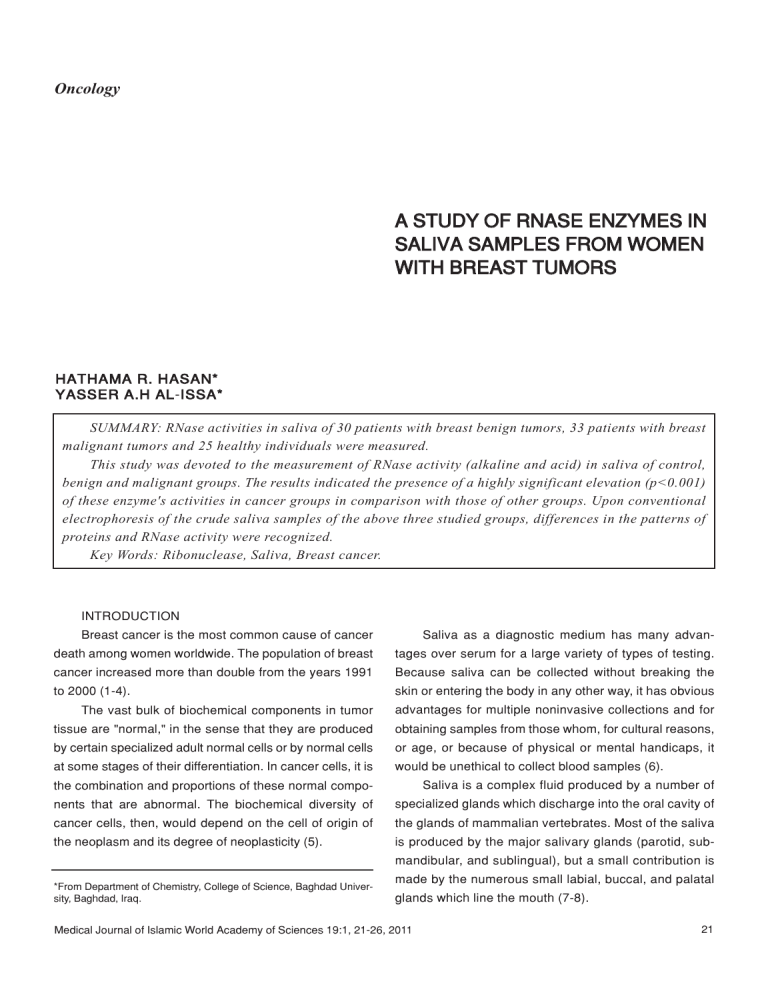
Oncology
A STUDY OF RNASE ENZYMES IN
SALIVA SAMPLES FROM WOMEN
WITH BREAST TUMORS
HATHAMA R. HASAN*
YASSER A.H AL-II SSA*
SUMMARY: RNase activities in saliva of 30 patients with breast benign tumors, 33 patients with breast
malignant tumors and 25 healthy individuals were measured.
This study was devoted to the measurement of RNase activity (alkaline and acid) in saliva of control,
benign and malignant groups. The results indicated the presence of a highly significant elevation (p<0.001)
of these enzyme's activities in cancer groups in comparison with those of other groups. Upon conventional
electrophoresis of the crude saliva samples of the above three studied groups, differences in the patterns of
proteins and RNase activity were recognized.
Key Words: Ribonuclease, Saliva, Breast cancer.
INTRODUCTION
Breast cancer is the most common cause of cancer
Saliva as a diagnostic medium has many advan-
death among women worldwide. The population of breast
tages over serum for a large variety of types of testing.
cancer increased more than double from the years 1991
Because saliva can be collected without breaking the
to 2000 (1-4).
skin or entering the body in any other way, it has obvious
The vast bulk of biochemical components in tumor
advantages for multiple noninvasive collections and for
tissue are "normal," in the sense that they are produced
obtaining samples from those whom, for cultural reasons,
by certain specialized adult normal cells or by normal cells
or age, or because of physical or mental handicaps, it
at some stages of their differentiation. In cancer cells, it is
would be unethical to collect blood samples (6).
the combination and proportions of these normal compo-
Saliva is a complex fluid produced by a number of
nents that are abnormal. The biochemical diversity of
specialized glands which discharge into the oral cavity of
cancer cells, then, would depend on the cell of origin of
the glands of mammalian vertebrates. Most of the saliva
the neoplasm and its degree of neoplasticity (5).
is produced by the major salivary glands (parotid, submandibular, and sublingual), but a small contribution is
*From Department of Chemistry, College of Science, Baghdad University, Baghdad, Iraq.
made by the numerous small labial, buccal, and palatal
glands which line the mouth (7-8).
Medical Journal of Islamic World Academy of Sciences 19:1, 21-26, 2011
21
RNASE ENZYMES IN WOMEN WITH BREAST TUMORS
HASAN, AL-ISSA
Table 1: Protein concentration, RNase activity and Specific activity in the saliva samples for the three studied group.
Age
Groups
Years
Total protein mg/ml
(mean ± Standard
deviation)
Samples
Activities U/L
(mean ± Standard Deviation)
Specific Activities U/mg
(mean ± Standard Deviation)
Alkaline
RNase
Acid
RNase
Alkaline
RNase
Acid
RNase
Control
25
23-71
(2.545 ± 0.69)
(17.20 ± 10.5)
(17.68 ± 8.28)
(6.58 ± 2.97 )
(7.02 ± 2.78)
Benign
30
21-69
(4.528 ± 2.64)
(161.76 ± 7.83)
(153.57 ± 104.42)
(36.67 ± 14.04)
(33.81 ± 10.51)
Malignant
33
28-71
(9.72 ± 2.06)
(842.32 ± 40.47)
(837.325 ± 274.46)
(87.11 ± 19.26)
(85.19 ± 16.81)
Mixed saliva containing (97-9.5)% water and the
rest is solid. Solids are the organic substances and inorganic substances. Gases are also found in saliva (9).
Previously it was noted that saliva supplies
enzymes for digestion. These enzymes and other proteins, including saliva-specific glycoproteins, are synthe-
MATERIALS AND METHODS
This study included two groups of breast tumor patients,
30 cases benign and 33 cases malignant serous breast tumor
in different stages. These two groups were matched with a
group of age matched healthy individuals (25 control), who
were used as a control group.
All patients were admitted to; AL-Ilwia Hospital, Center of
sized by the acinar cells. The transport of proteins into
Early Detection of Breast Cancer. They were histologically
saliva has been reviewed by Young (10). Almost all of
proven under the supervision of specialists: - Dr. Perlant Asker
the organic compounds of plasma, such as hormones,
Mahmood appling Fine Needle Aspirate (FNA) cytological study
immunologlobulines, enzymes, DNA and viruses may be
for diagnosis of breast cancer.
Saliva samples were collected in the morning from the
detected in saliva in trace amounts (8).
Human ribonuclease is widely distributed in various
organs (11) such as pancreas and body fluids (12),
including serum, urine, saliva and cerebrospinal fluid.
According to the current situation of RNase, the relevant studies on this enzyme in the saliva indicated the
patients and healthy women after thoroughly rinsing the mouth
without any stimulation. The saliva was centrifuged (2000*g) for
10 min after collection and the supernatant was stored at (-20)οC
until being used for different investigations. A modified Lowry
method by Hartree (13) was used to determine saliva total proteins using Bovine Serum Albumin (BSA) as a standard.
importance of this enzyme in this biological fluid, as a
diagnostic tool but most of them gave a special refer-
Determination of alkaline RNase activity in the saliva samples
ence to the activity measurement and lack of some of
Determination of alkaline RNase activity in saliva was carried out according to Bardon et.al method (14) with some mod-
the important biochemical and biological aspects.
As such the intention to study the following lines
ifications. Reaction mixture 1.1 ml containing 1 ml buffered
substrate solution (Davis buffer)(15) and a volume of saliva
was arised:
1) Evaluating acid and alkaline RNase activities in
which contain 100 μg of total protein were incubated for 15 min
at 37οC. After the incubation period, the reaction mixture was
saliva of the control women in comparison with that of
cooled to 0οC and mixed with an equal volume of HCl (1 M) in
the patients with benign and malignant breast tumors.
70% ethanol and left for 30 min. The samples were centrifuged
2) Detecting the changes in the forms of alkaline
RNase enzyme that occurred upon malignancy.
22
at (2000*g) for 10 min. and the supernatant was diluted with distilled water (1:5). The absorbencies were measured at (λ=260)
Medical Journal of Islamic World Academy of Sciences 19:1, 21-26, 2011
RNASE ENZYMES IN WOMEN WITH BREAST TUMORS
Figure 1: Conventional-PAGE electrophoresis profile of crude
saliva, electrophoresis was carried out using 12.5% acrylamide, 30mA current, the gel was stained for protein.
Malignant
+
11
Control
Benign
Malignant
6
1
-
Direction of migration
+
Benign
Figure 2: Conventional-PAGE electrophoresis profile of
crude saliva, the gel was stained for alkaline RNase
activity.
-
Direction of migration
Control
HASAN, AL-ISSA
1
Statistical analysis
nm. The control was treated as the test sample except the
sample was added after the addition of HCl (1 M) in (70%)
The data throughout this work was reported in the form of
ethanol. The activity of the enzyme was expressed in U/L and
(mean value ± standard deviation). Quantitative differences
calculated as follows:
between groups were determined by student T-test, where differences was considered as highly significant when (p<0.001).
RNase Activity
U
L
=
(ΔA*Vt*dilution factor)
t*(Vs)2
RESULTS
Ribonuclease was reported to be present in healthy
Where:
ΔA= Sample's absorbance - Control's absorbance
Vt= the total volume (ml)
Vs= the volume of saliva used (ml)
human saliva in at least two different types: acid and
alkaline RNase (14). In the present study acid and alkaline RNase activities were measured in the saliva sam-
t= the incubation time (min)
ples of healthy women and women with different types of
Whereas the specific activity was expressed unit of
breast tumors (see above). Table 1 lists the measured
enzyme activity per mg of protein.
protein concentration, RNase activity (using yeast RNA
as a substrate) and its specific activity in the saliva of
Determination of Acid RNase activity in the saliva samples
these different samples.
The same method described above for the determination
of alkaline RNase activity was used except that the pH of Davis
buffer was adjusted to 5.
Conventional polyacrylamide gel electrophoresis
PAGE 12.5% technique developed by Lammeli (16), was
A highly significant increase in RNase activity and
their specific activity were observed. It is clear from the
results presented in the table that RNase activity and
specific activity increased highly significantly in saliva
samples of patients with benign (p<0.001) and that of
used to analyze the crude saliva of control group and groups
malignant breast tumors (p<0.001), compared with the
with breast tumors. The gel was stained for protein (17), glyco-
healthy group (Table 1). The changes in saliva protein
protein (18) and RNase activity (19, 20).
concentration of the studied groups were similar to that of
Medical Journal of Islamic World Academy of Sciences 19:1, 21-26, 2011
23
RNASE ENZYMES IN WOMEN WITH BREAST TUMORS
HASAN, AL-ISSA
the RNase activity, but the differences between the
in the present study. In addition to this the alteration in
groups were less pronounced.
cell permeability of tumor cells membranes where a
The activity of the RNase enzyme, in the saliva of
number of changes in the biochemical characteristic of
women with benign tumors is more than that in healthy
malignant cell surface have been observed. These
saliva samples in about (8.6) fold when measured at
include the appearance of new surface antigen proteo-
acidic pH, and (9.4) fold when the activity was measured
glycans, glycolipids, and mucins, and altered cell-cell and
at alkaline pH, whereas the elevation in the activity was
cell-extracellular matrix communication (30). Such
(47.3) and (48.9) folds higher in the saliva of patients with
changes may lead to transport of different enzymes from
malignant breast tumors, when measured at acidic and
the blood to the saliva via salivary glands, and one of
alkaline pH respectively, upon comparison with that of
these enzymes may be RNase. Furthermore, a transport
healthy individuals.
of some activators for RNase activity such as the cations
from the blood to saliva was reported to accompany the
DISCUSSION
presence of some disease such as cystic fibrosis (31).
Little is actually known about human salivary
Such transport may be one of the mechanisms that lead
RNases, though there are some reports which indicated
also to the observed elevation in the present study in sali-
the presence of a significant elevation in this activity in
vary RNase activity.
saliva of patients with different disease such as cystic
Conventional electrophoresis using Lammali system
fibrosis (16) and influenza (21) and ovarian tumors (22),
in the presence of 12.5% acrylamide as a separating gel,
while non significant increase was reported in the activity
was used, in order to detect any differences in proteins
of salivary RNase of patient with oral tumors (23).
and RNase profiles Saliva protein elelctrophoregrams of
The elevation in RNase activities reported in present
each group were characterized by some protein patterns
study may be due to one of the following reasons: gener-
typical for particular group. Saliva of the first group (con-
ally it is known that cancer cells are characterized by
trol) contained up to 11 protein bands different in its
uncontrolled increase in the number of cells and their
molecular mass, while electrophoresis of saliva samples
sizes (24), which means that there will be an increase in
of the second group (benign) was characterized by signif-
the synthesis of different proteins and this explains the
icant reduction of proteins bands (about 6 protein bands).
need for high RNase activity. Also cancer cells will relay
But in the malignant group (third group) the electrophore-
on anaerobic oxidation as a source of energy by forming
sis patterns of saliva proteins revealed up to 7 proteins,
lactate. It was originally thought that there is hypoxia
figure (1). This can be explained by the deletion hypothe-
areas only in the center of tumors and remained relatively
sis of cancer proposed by Miller (32), which suggested
static and eventually became necrotic, while later it was
that carcinogenesis resulted from a permanent alteration
known that hypoxic areas actually come and go in a
or loss of protein essential for the control of growth.
tumor as perfusion varies and as new blood vessels
Potter (33) suggested that the proteins lost during car-
form, fade away, and then reform (25).
cinogenesis may be involved in the feedback control of
Lactate acidosis has been shown to activate the
enzymes systems required for cell division. There were
biosynthesis of some acid hydrolyases, to cause release
insignificant variations of proteins bands within each
of lysozomal enzymes, to disturb calcium metabolism
group, but they did not affect the characteristic pattern of
and change the permeability of cell membranes (26-28).
saliva proteins content typical for these groups. The elec-
Further, it has been shown that decreased intracellular
trophoresis pattern of saliva samples for the three studied
pH and a decreased ATP level will cause an increase
groups, which were stained for RNase activity, is shown
release of proteins from tissues into different body fluids
in figure (2). Six activity bands appeared in the saliva of
(28, 29), which are in concordance with results obtained
each group, four of them traveled in the gel to the same
24
Medical Journal of Islamic World Academy of Sciences 19:1, 21-26, 2011
RNASE ENZYMES IN WOMEN WITH BREAST TUMORS
HASAN, AL-ISSA
distance, while the other two traveled with different mobil-
a promising parameter that may be used to differentiate the
ity. Band number 5 in the saliva of the control group
presence of malignancy. Further study is carrying out in our
seems to move further than that present in the saliva of
laboratory to check the selectivity of this biochemical marker.
the benign and malignant groups, while band number 6 in
the control group moves slower distance than the same
ACKNOWLEDGEMENTS
band in the other two groups.
1. Chemistry Department, College of Science, University of Baghdad.
CONCLUSION
Out of the result of the present study, RNase seems to be
2. Dr. Perlant Asker Mahmood, Center of Early Detection of Breast Cancer. AL-Ilwia Hospital.
REFERENCES
1. Iraqi Cancer Registry Results (1993). Ministry of Health
15. Davis MT : A universal buffer solution for use in ultraviolet spectrophotometry. 84:248-251, 1958.
2. Iraqi Cancer Registry Results (1995). Ministry of Health
16. Laemmli UK : Cleavage of structural proteins during the
3. Iraqi Cancer Registry Results (1998). Ministry of Health
assembly of the head of bectriophage T4. Nature, 227:680-686,
4. Iraqi Cancer Registry Results (2000). Ministry of Health.
1970.
17. SDS and conventional PAGE with LKB 2117 Multiphor
5. Knox WE : Enzyme patterns in fetal, adult, and neoplastic
rat tissues. 2nd ed, Basel:S Karger; 1976.
LKB application note-Sweeden, 1977.
18. Leach BS, Collawn JF, Fish WW : Methods in Enzymeol-
6. Hofman LF : Human Saliva as a Diagnostic Specimen.
Journal of Nutrition, 131:1621S-1625S, 2001.
ogy. Ed by Deutscher MP, Academic press, Inc, USA, p 536, 1990.
7. Van Dam JG, Van Loenen AC : De aanwezigheid van
19. Ester FS, Rosa P, Marshal Frazier, Rafael D : Ribonucle-
geneesmiddelen in speeksel. Pharmaceutisch Weekblad. 113:65-
ases expressed by human pancreatic adenocarcinoma cell lines.
74, 1978.
Eur J Biochem, 267: 1484-1494, 2000.
20. Bravo J, Fernandez E, Ribo M, de Llorens R, Cuchillo
8. Vining RF, McGinley RA : Hormones in saliva. Critical
Reviews in Clinical Laboratory. Sciences, 23: 95-146, 1985.
9. Sembulingam K, Sembulingam P : Essentials of medical
CM : A versatile negative-staining ribonuclease zymogram. Anal
Biochem, 219: 82-86, 1994.
21. Adigamov LF, Zbarsky JB : Human saliva RNA-se activ-
physiology. 3rd edition, chapter 37:169-172, 2005.
10. Young JA, Van Lennep EW : Transport in salivary and
salt glands. In: Membrane transport in biology. Ed by G Giebisch,
ity in normal and pathological conditions. Vopr Med Khim, 15, 8391, 1969.
22. Hasan HR, Al-Shaikhly OR : RNases in sera and saliva
DC Tosteson, HH Ussing, pp. 563-674, 1979.
11. Peracaula R, Cleary KR, Lorenzo J, de Llorens R, Fra-
of healthy and women patients with benign and malignant ovarian
zier ML: Human pancreatic Ribonuclease 1: Expression and distri-
tumors-A comparative study. Selected Research Papers, Vol 5,
bution in pancreatic adenocarcinoma. Cancer, 89:1252-1258,
40-56, 2005.
23. Daoud RM : Study of Some Biochemical Changes in
2000.
12. Levy AL, Rottino A : Effect of disease states on the
Serum and Saliva of Patient with Oral Epithelial Tumors. PhD
ribonuclease concentration of body fluids. Clin Chem, Feb, 6:43-
thesis, supervisor by Dr Hathama R Hasan, department of chem-
51, 1960.
istry, the collage of science, university of Bagdad, 2008.
24. Weinberg RA : The biology of cancer. Garland Science,
13. Hartree EF : Determination of protein: a modification of
the Lowry method that gives a linear photometric response. Anal
New York, 2006.
25. Holash J, Maisonpierre PC, Compton D : Vessel coop-
Biochem, 48(2):422-427, 1972.
14. Bardon A, Shugar D : Properties of purified salivary
ribonuclease, and salivary ribonuclease levels in children with
tion, regression, and growth in tumors mediated by engiopoietins
and VEGF. Science, 283:1994-1998, 1999.
26. Haralambie G, Cerny FJ : Changes in serum lysozyme
cystic fibrosis and in heterozygous carriers. Clin Chim Acta, 14;
101(1):17-24, 1980.
activity with physical exercise. Clin Chem Acta, 55:217-224, 1974.
Medical Journal of Islamic World Academy of Sciences 19:1, 21-26, 2011
25
RNASE ENZYMES IN WOMEN WITH BREAST TUMORS
HASAN, AL-ISSA
27. Renoe BW, McDonald JM, Ladenson JH : The effects of
32. Miller EC, Miller JA : The presence and significance of
stasis with and without exercise on free calcium, varios cations,
bound aminoazo dyes in the livers of rats fed p-dimethylaminoa-
and related parameters. Clin Chem Acta, 103:91-100, 1980.
zobenzene. Cancer Res, 7:468-480, 1947.
28. Tizianello A, De Firrari G, Gurreri G, Acquarone N :
Effects of metabolic alkosis, metabolic acidosis and uraemia on
33. Potter VR : The biochemical approach to the cancer
problem. Fed Proc, 17:691-698, 1958.
whole-body intracellular pH in man. Clin Sci Mol Med, 52:125135, 1977.
29. Thomson WHS, Sweetin JC, Hamilton IJD : ATP and
muscle enzyme efflux after physical exertion. Ciln Chem Acta,
59:241-245, 1975.
30. Bast RC, Kufe DW, Pollock RE, Weichselbaum RR, Holland JF, Frei E : Cancer Medicine, 5th Ed, 2000.
31. Bardon A, Ceder O, Kollberg H : Cystic fibrosis-like
changes in saliva of healthy persons subjected to anaerobic exercise. 133: 311-316, 1983.
26
Correspondence:
Yasser A.H AL-Issa
Department of Chemistry,
College of Science,
Baghdad University,
Baghdad, IRAQ.
e-mail: [email protected]
Medical Journal of Islamic World Academy of Sciences 19:1, 21-26, 2011

